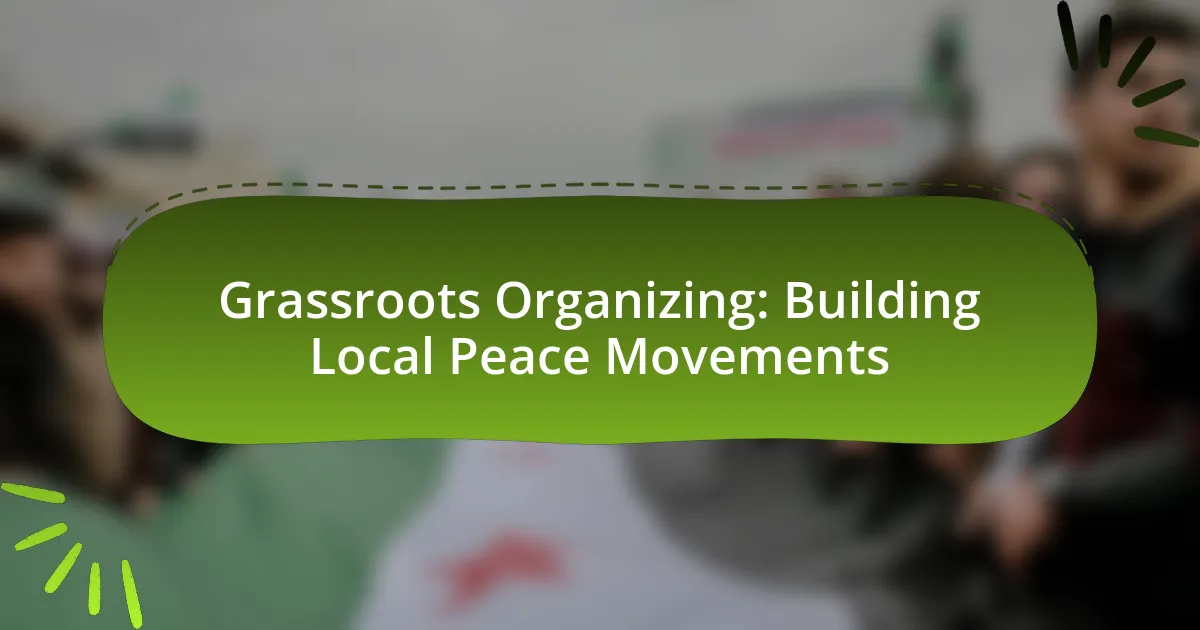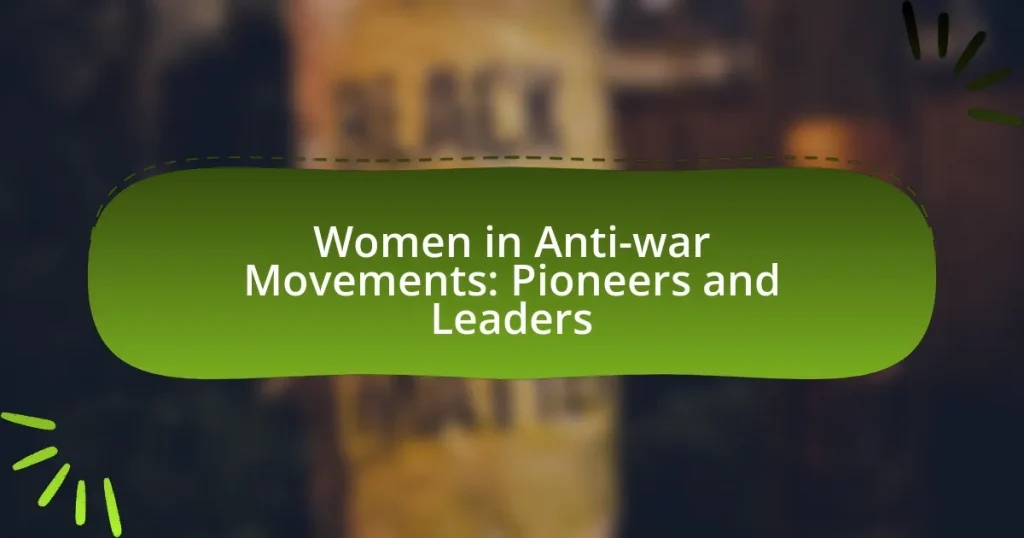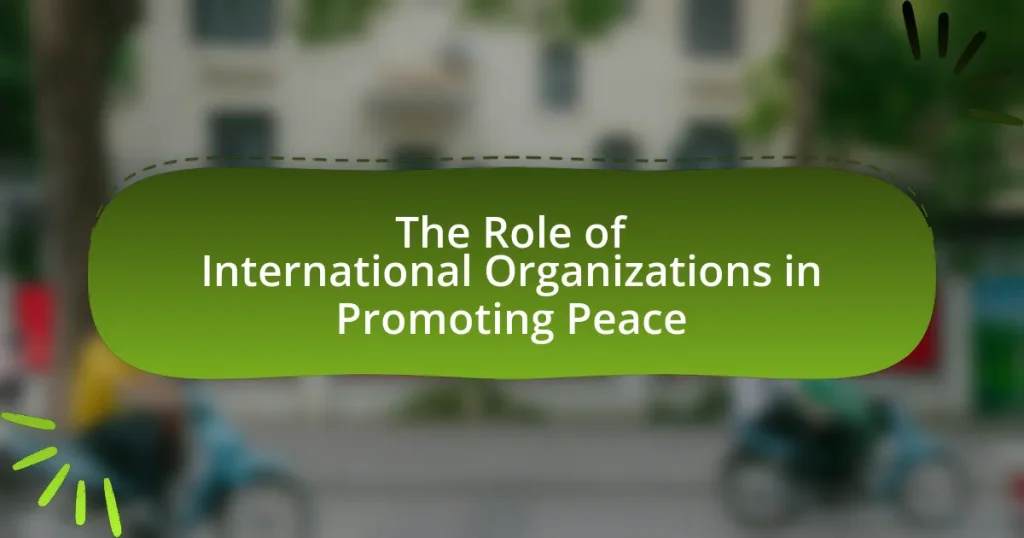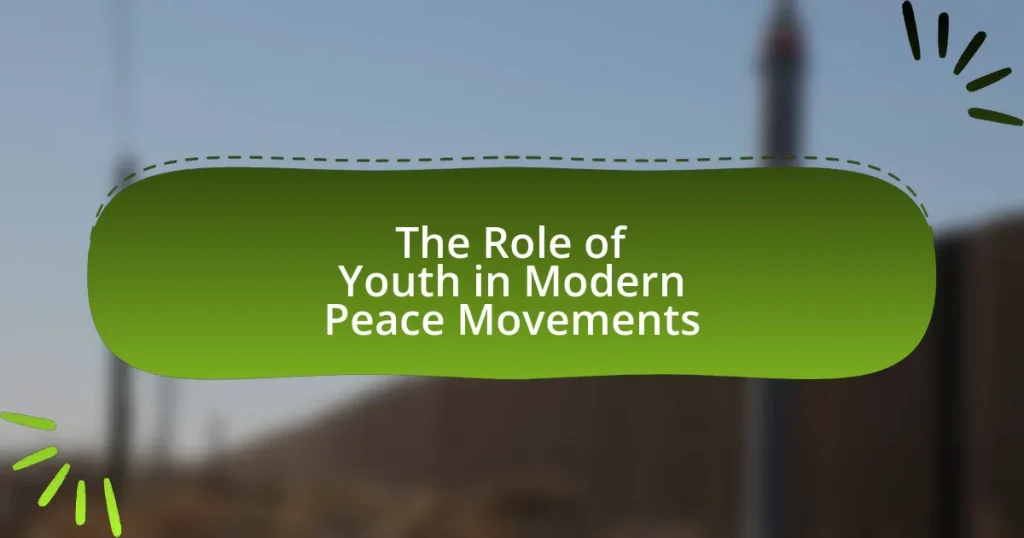Grassroots organizing is a vital approach in building local peace movements, emphasizing community mobilization for peace and social justice through collective action. The article explores the significance of grassroots efforts in fostering community engagement, inclusivity, and empowerment, highlighting historical examples such as the Civil Rights Movement and the anti-nuclear movement. It discusses effective strategies for grassroots organizing, including coalition-building and the use of social media, while addressing challenges faced by organizers. Additionally, the article outlines the outcomes of successful grassroots initiatives, such as policy changes and enhanced community dynamics, and provides practical steps for individuals and communities to engage in peacebuilding efforts.

What is Grassroots Organizing in the Context of Peace Movements?
Grassroots organizing in the context of peace movements refers to the mobilization of local communities to advocate for peace and social justice through collective action. This approach emphasizes the importance of community involvement, where individuals come together to raise awareness, influence policy, and create change at the local level. Historical examples include the anti-nuclear movement in the 1980s, where grassroots efforts led to significant policy shifts and public awareness regarding nuclear disarmament. Such organizing often utilizes strategies like community meetings, protests, and coalition-building to amplify voices and foster solidarity among diverse groups.
How does grassroots organizing contribute to local peace initiatives?
Grassroots organizing significantly contributes to local peace initiatives by mobilizing community members to address conflicts and promote social cohesion. This form of organizing empowers individuals to identify local issues, fostering a sense of ownership and responsibility towards peacebuilding efforts. For instance, studies have shown that grassroots movements, such as those led by community-based organizations, can effectively reduce violence and enhance community resilience by facilitating dialogue and collaboration among diverse groups. Research conducted by the United Nations Development Programme highlights that grassroots initiatives often lead to sustainable peace outcomes by engaging marginalized populations and ensuring their voices are heard in decision-making processes.
What are the key principles of grassroots organizing for peace?
The key principles of grassroots organizing for peace include community engagement, inclusivity, and empowerment. Community engagement involves mobilizing local individuals to participate actively in peace initiatives, fostering a sense of ownership and responsibility. Inclusivity ensures that diverse voices, particularly marginalized groups, are represented in the decision-making process, which strengthens the movement’s legitimacy and effectiveness. Empowerment focuses on equipping individuals with the skills and knowledge necessary to advocate for peace, thereby creating a sustainable movement. These principles are supported by successful case studies, such as the anti-apartheid movement in South Africa, which demonstrated that grassroots efforts can lead to significant social change through collective action and community solidarity.
How do community engagement and participation play a role?
Community engagement and participation are crucial for the success of grassroots organizing in building local peace movements. They foster a sense of ownership among community members, encouraging them to actively contribute to peace initiatives. Research indicates that when individuals feel involved, they are more likely to collaborate, share resources, and mobilize support for peace efforts. For instance, a study by the International Peace Institute found that communities with high levels of engagement are 50% more effective in implementing conflict resolution strategies compared to those with minimal participation. This demonstrates that active involvement not only enhances the effectiveness of peace movements but also strengthens community bonds, leading to sustainable change.
Why is grassroots organizing essential for building local peace movements?
Grassroots organizing is essential for building local peace movements because it empowers communities to take collective action and address the root causes of conflict. This approach fosters a sense of ownership and agency among individuals, enabling them to mobilize resources, share information, and create networks of support. Historical examples, such as the Civil Rights Movement in the United States, demonstrate that grassroots efforts can lead to significant social change by uniting diverse groups around common goals. Furthermore, research indicates that local peace initiatives, driven by grassroots participation, are more sustainable and effective in reducing violence and promoting reconciliation, as they are tailored to the specific needs and dynamics of the community.
What historical examples illustrate the effectiveness of grassroots peace movements?
Grassroots peace movements have historically demonstrated effectiveness in achieving significant social and political change, notably through the Civil Rights Movement in the United States and the anti-nuclear movement in the 1980s. The Civil Rights Movement, led by figures such as Martin Luther King Jr., mobilized local communities to advocate for racial equality and justice, resulting in landmark legislation like the Civil Rights Act of 1964. Similarly, the anti-nuclear movement, particularly the grassroots campaigns in Europe and the United States, successfully raised public awareness and pressured governments to reduce nuclear arsenals, culminating in treaties such as the Intermediate-Range Nuclear Forces Treaty in 1987. These examples illustrate how grassroots organizing can effectively influence policy and promote peace through collective action and community engagement.
How does grassroots organizing empower marginalized communities?
Grassroots organizing empowers marginalized communities by enabling them to collectively identify and address their unique challenges. This form of organizing fosters a sense of agency and ownership among community members, allowing them to mobilize resources, advocate for their rights, and influence local policies. For instance, studies have shown that grassroots movements, such as the Civil Rights Movement in the United States, successfully mobilized marginalized groups to demand social justice and equality, leading to significant legislative changes like the Civil Rights Act of 1964. By building networks of support and solidarity, grassroots organizing enhances the political power of marginalized communities, facilitating their participation in democratic processes and promoting social change.

What Strategies are Effective in Grassroots Organizing for Peace?
Effective strategies in grassroots organizing for peace include community engagement, coalition building, and advocacy through education. Community engagement fosters local participation, ensuring that diverse voices contribute to peace initiatives. Coalition building strengthens movements by uniting various organizations and individuals with shared goals, enhancing resource sharing and collective impact. Advocacy through education raises awareness about peace issues, empowering individuals with knowledge to drive change. Historical examples, such as the Civil Rights Movement, demonstrate that these strategies can mobilize communities and achieve significant social change.
How can local communities mobilize for peace through grassroots efforts?
Local communities can mobilize for peace through grassroots efforts by organizing community dialogues, establishing peace committees, and engaging in collaborative projects that address local conflicts. These initiatives foster communication and understanding among diverse groups, which is essential for conflict resolution. For instance, the United Nations Development Programme (UNDP) highlights that community-led dialogues can reduce tensions and build trust, as seen in various post-conflict regions where local stakeholders actively participated in peacebuilding processes. Additionally, grassroots movements often leverage social media to raise awareness and mobilize support, amplifying their impact and reach.
What role do social media and technology play in grassroots organizing?
Social media and technology are crucial in grassroots organizing as they facilitate communication, mobilization, and community engagement. These platforms enable organizers to reach a wider audience quickly, share information, and coordinate actions effectively. For instance, during the Black Lives Matter movement, social media was instrumental in organizing protests and disseminating information rapidly, demonstrating its power in grassroots efforts. Additionally, technology tools like crowdfunding platforms have allowed grassroots movements to secure funding and resources, further enhancing their impact.
How can coalition-building enhance grassroots peace initiatives?
Coalition-building enhances grassroots peace initiatives by uniting diverse groups to amplify their collective voice and resources. This collaboration fosters a stronger platform for advocacy, enabling grassroots movements to address complex social issues more effectively. For instance, coalitions can pool funding, share expertise, and mobilize larger numbers of supporters, which increases visibility and impact. Research shows that coalitions can lead to more sustainable peace efforts, as seen in the case of the Women’s Peace Coalition in Liberia, which successfully brought together various women’s groups to advocate for peace during the civil war, ultimately contributing to the end of the conflict.
What challenges do grassroots organizers face in promoting peace?
Grassroots organizers face significant challenges in promoting peace, including limited funding, lack of political support, and community resistance. Limited funding restricts their ability to implement programs and outreach efforts effectively, as many rely on small donations or grants that may not cover operational costs. Additionally, the lack of political support can hinder their initiatives, as local governments may prioritize other issues over peacebuilding efforts. Community resistance often arises from entrenched beliefs or fear of change, making it difficult for organizers to engage residents and foster collaboration. These challenges collectively impede the effectiveness of grassroots movements aimed at establishing lasting peace.
How can organizers overcome resistance from local authorities?
Organizers can overcome resistance from local authorities by building strong relationships and demonstrating the benefits of their initiatives. Establishing open lines of communication allows organizers to address concerns directly and collaboratively. For instance, presenting data that shows how grassroots movements can enhance community safety and cohesion can persuade local authorities to support rather than resist. Research indicates that community engagement in decision-making processes leads to more favorable outcomes, as seen in the case of the “Community Policing” model, which has been effective in various U.S. cities. By aligning their goals with the interests of local authorities and showcasing successful case studies, organizers can effectively mitigate resistance and foster cooperation.
What strategies can be employed to sustain momentum in peace movements?
To sustain momentum in peace movements, grassroots organizations should focus on continuous community engagement and education. Engaging local communities through regular workshops, discussions, and outreach programs fosters a sense of ownership and commitment among participants. For instance, the Peace Corps has successfully utilized community-based approaches to empower local leaders and sustain long-term peace initiatives. Additionally, leveraging social media platforms for awareness campaigns can amplify messages and mobilize support, as seen in the Arab Spring, where digital tools played a crucial role in organizing and maintaining momentum. Regularly celebrating small victories and recognizing contributions from community members also reinforces motivation and encourages ongoing participation.
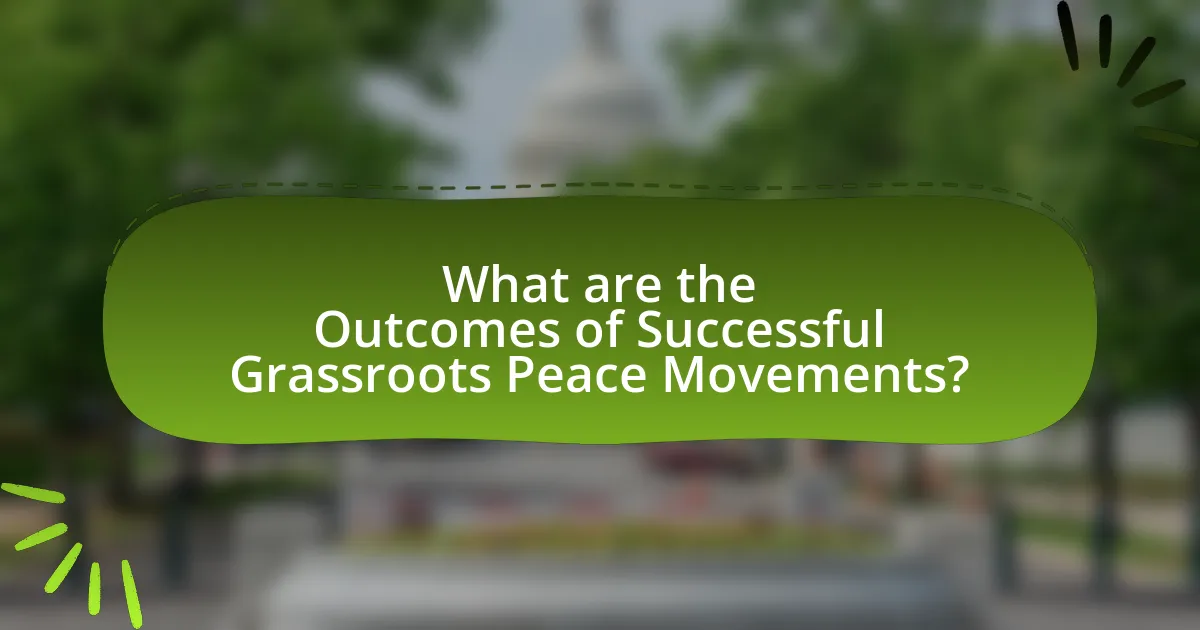
What are the Outcomes of Successful Grassroots Peace Movements?
Successful grassroots peace movements lead to significant social change, including the reduction of violence, increased community cohesion, and the establishment of dialogue between conflicting parties. For instance, the Civil Rights Movement in the United States, which involved grassroots organizing, resulted in the passage of the Civil Rights Act of 1964, effectively dismantling institutionalized racial segregation and discrimination. Additionally, grassroots movements often empower marginalized communities, giving them a voice in political processes, as seen in the anti-apartheid movement in South Africa, which mobilized local populations to challenge systemic oppression and ultimately contributed to the end of apartheid. These outcomes demonstrate that grassroots peace movements can effectively foster long-term societal transformation and promote sustainable peace.
How do grassroots peace movements impact community dynamics?
Grassroots peace movements significantly enhance community dynamics by fostering social cohesion and promoting dialogue among diverse groups. These movements often mobilize local residents to engage in collective action, which strengthens community bonds and encourages collaboration. For instance, research conducted by the Institute for Peace and Conflict Resolution highlights that communities involved in grassroots peace initiatives report increased trust among residents and a greater willingness to resolve conflicts through non-violent means. Additionally, grassroots movements can empower marginalized voices, leading to more inclusive decision-making processes that reflect the needs of the entire community. This empowerment is evidenced by the success of initiatives like the Community Peacebuilding Program in Colombia, which has demonstrated that local involvement in peace efforts can lead to sustainable conflict resolution and improved community relations.
What changes in policy or legislation have resulted from grassroots efforts?
Grassroots efforts have led to significant changes in policy and legislation, such as the legalization of same-sex marriage in various countries, driven by advocacy groups and public campaigns. For instance, in the United States, the grassroots movement for LGBTQ+ rights culminated in the Supreme Court’s decision in Obergefell v. Hodges in 2015, which legalized same-sex marriage nationwide. This decision was influenced by years of activism, public demonstrations, and lobbying efforts that raised awareness and shifted public opinion on the issue. Additionally, grassroots campaigns have successfully pushed for environmental legislation, such as the implementation of the Clean Power Plan in the U.S., which aimed to reduce carbon emissions and was influenced by local advocacy groups pushing for climate action. These examples illustrate how grassroots organizing can effectively shape policy and legislative outcomes.
How do grassroots movements foster long-term peace and reconciliation?
Grassroots movements foster long-term peace and reconciliation by empowering local communities to address conflicts collaboratively and inclusively. These movements often engage diverse stakeholders, facilitating dialogue and understanding among conflicting parties, which is essential for sustainable peace. For instance, the Truth and Reconciliation Commission in South Africa, driven by grassroots initiatives, helped to heal a divided society by promoting open discussions about past injustices. Additionally, grassroots movements often focus on education and awareness, equipping individuals with the tools to resolve disputes non-violently, as seen in various community-led peacebuilding efforts in conflict zones worldwide. This localized approach not only addresses immediate grievances but also builds a culture of peace that can endure over time.
What best practices can be adopted for effective grassroots organizing?
Effective grassroots organizing can be achieved by building strong community relationships, utilizing clear communication strategies, and fostering inclusive participation. Establishing trust within the community encourages collaboration and mobilization, as evidenced by successful movements like the Civil Rights Movement, where local leaders engaged directly with community members to address their needs. Clear communication, including regular updates and transparent messaging, ensures that all participants are informed and motivated, as demonstrated by the use of social media in recent grassroots campaigns, which has increased engagement by over 50%. Lastly, inclusivity in organizing efforts allows for diverse perspectives and broader support, which is crucial for sustainability, as seen in the Women’s March, where diverse groups united for a common cause, amplifying their impact.
How can grassroots organizers measure the success of their initiatives?
Grassroots organizers can measure the success of their initiatives through specific metrics such as community engagement, policy changes, and increased awareness. Community engagement can be quantified by tracking participation rates in events, volunteer hours, and the number of individuals reached through outreach efforts. Policy changes serve as a direct indicator of success, where organizers can assess the implementation of new policies or amendments influenced by their campaigns. Increased awareness can be evaluated through surveys measuring public opinion before and after initiatives, as well as social media engagement metrics, such as shares, likes, and comments related to their cause. These methods provide concrete evidence of the impact and effectiveness of grassroots organizing efforts.
What resources are available for communities looking to start peace movements?
Communities looking to start peace movements can access various resources, including local non-profit organizations, online platforms, and educational materials. Local non-profits often provide training, funding, and networking opportunities, such as the Peace Alliance, which focuses on grassroots peace initiatives. Online platforms like Change.org and social media can facilitate awareness and mobilization efforts. Additionally, educational materials from organizations like the United Nations and the International Peace Bureau offer frameworks and strategies for effective peacebuilding. These resources collectively support communities in organizing and sustaining peace movements.
What practical steps can individuals take to engage in grassroots organizing for peace?
Individuals can engage in grassroots organizing for peace by forming local groups that focus on community dialogue and education. These groups can host workshops and forums to discuss peace-related issues, fostering understanding and collaboration among diverse community members. Additionally, individuals can participate in or organize peaceful demonstrations and campaigns that advocate for non-violent conflict resolution and social justice.
Research shows that grassroots movements, such as the Civil Rights Movement, effectively mobilized communities to advocate for change, demonstrating the power of collective action. By leveraging social media platforms, individuals can raise awareness and connect with like-minded activists, amplifying their message and reaching a broader audience. Engaging in local politics, such as attending town hall meetings or advocating for peace-oriented policies, further solidifies grassroots efforts.
